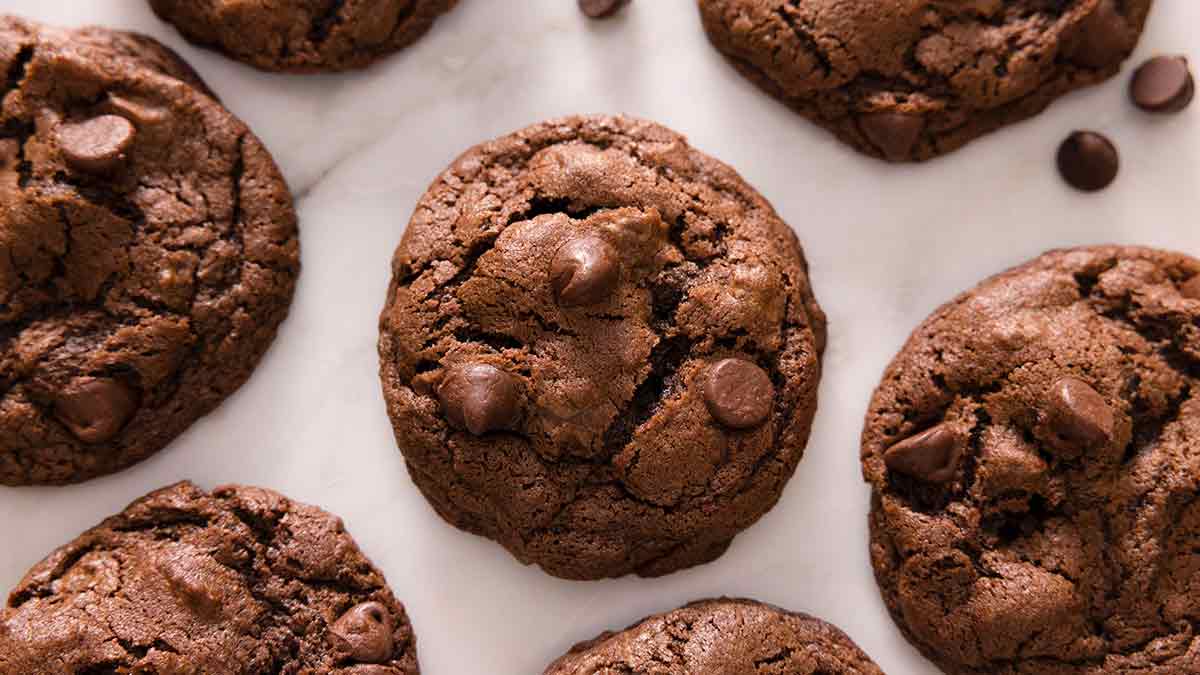Making double chocolate chip cookies (or any baked dessert) is essentially a scientific experiment. The experiment will only be successful when every component is correctly mixed and the chemistry is perfect.
The process of baking cookies: Butter and sugar are mixed together, then dry ingredients like flour, baking soda, and salt are added, and the mixture is cooked to the perfect temperature. It’s also crucial to accurately measure ingredients to ensure the final product has the right texture and taste.
Thankfully, the Topping Solutions Test Kitchen has tried and tested various chocolate chip cookie doughs, so you won’t have to risk a failed experiment when making changes to your recipe.
Here are the important facts you need to know before baking cookies.
1. More Butter = A Wider Spread & More Tenderness In Cookies.
Shortening-based cookies are softer but denser than butter-based cookies.
The way Butter is added have an impact on texture. Cool Butter is beaten until it’s light and fluffy in the early stages of creating a cookie. Part air is included throughout the process, and some of the sugar dissolves in the aqueous phase of the Butter.
As the cookies bake, the air helps to leaven them and give them lift. Denser cookies result from melting Butter before mixing it with sugar and eggs.
2. Melted Butter = Denser Cookies & Creamed Butter = Crispier Cookies
I thought to myself if browning milk proteins adds taste to cookies, how could I amp it up even more?
However, it creates new issues. Brown Butter contributes no moisture to the dough because it can’t become heated enough to brown milk proteins until all water content has evaporated. Sugar that is put into browned Butter without water will not dissolve, making it more difficult for them to melt together while the cookie bakes.
3. Extra Egg Whites = Taller Cookies & More Egg Yolks = Fudgier Cookies
It turns out that the ideal mix for me is a 1 to 1 ratio of egg whites to egg yolks, which is also how eggs occur in nature. Isn’t it amazing?
To keep things texturally interesting, it turns out that you need a balance of dissolved and undissolved sugar.
4. Too Much Dissolved Sugar = Uniform Texture & Less Cracking
The amount of time the Butter is allowed to cool before being added to the mixture may influence how well it retains air when combined with the eggs. Warm Butter is extremely easy to work with and does not hold bubbles well.
It gets denser as it cools, making it better at trapping air. It just takes a few degrees to make a significant impact. My browned Butter got solid enough to beat into the egg and sugar mixture without collapsing after I let it cool to nearly room temperature.
5. White Sugar = Thin & Crisp Cookies & Brown Sugar = Tall & Moist Cookies
Combining the two strikes a nice balance, and dissolving too much sugar may result in a too homogenous texture. The pockets of molten sugar that caramelize inside the cookie as it bakes stay irregular. The sugar remains in distinct grains, giving the biscuit additional tactile complexity.
On the other hand, brown sugar has an advantage over white sugar in that it caramelizes more quickly, resulting in a more intense taste.
6. Soda = Craggy & Coarse; Powder = Cakey & Smooth
I don’t like cakey cookies, and the brown sugar in my cookies supplied enough acid for the baking soda to react with. 3/4 teaspoon seems to be the perfect quantity.
Furthermore, baking soda significantly impacts how quickly foods darken and acquire browned tastes because the Maillard process occurs more rapidly in slightly alkaline conditions. When it comes to cookies, browning is a good thing.
7. More Bread flour = Chewier Cookies, & More Cake Flour = Softer Cookies
We found out that if you work carefully with the proportions of the other ingredients, you can get away with using ordinary all-purpose flour.
Because flour makes up the majority of a cookie’s structure, the quantity you use may affect the cookie’s texture. Cookies with a tiny amount of flour relative to Butter (a ratio of 1 to 1 or less) spread out into wafer-like lace cookies. Extra flour can result in cookies that hardly spread as they bake, with thick, dough-like cores even when they’re nearly done.
This may be a good thing for some people, but I like a great balance of the two in my cookies. I decided on a flour-to-butter ratio of 10 ounces flour to 8 ounces butter.
8. Less Kneading = Craggier Cookies & Better Texture
Even before baking, the dough scoops should have a natural cragginess to them.
If you want your cookies particularly craggy, we suggest tearing the dough balls apart with your fingers and mooshing them back together with the jagged split portion facing outwards.
Those crags should emerge in the final cooked shape of the cookies if you used enough flour and your other ratios are correct.
9. Hand-Chopped Chocolate = Most Intense Flavor & Interesting Texture
You may also customize the size of your chocolate pieces by hand cutting. I soon found that I like a lot of chocolate (a full 8 ounces) and that I prefer it in big pieces of 1/2 to 1/4 inch.
By gently stirring cookie dough that’s been warmed to over 95°F, or by adding chocolate into the dough that’s been let to rest in a warm place until it reaches above 95°F, you wind up distributing some melted chocolate throughout the works.

The result is a swirl effect that, if done correctly, may be very tasty. Still, you will lose out on the traditional big melty pockets.
I like cookies prepared with dough that has been gently swirled and warmed to 80°F. The smallest pieces of chocolate melt, while the bigger chunks remain solid.
10. Cookies Need A Greater Amount Of Salt Than You Would Think
A decent quantity of salt (and a lot of it) is required to balance the flavour of caramelized sugars, as is a large amount of vanilla (though our recent taste test has shown, even imitation vanilla flavouring will do just fine).
11. Low-Cost Vanilla = High-End Vanilla
Even though regular salt can be incorporated into the dough, I prefer to sprinkle coarse sea salt on the tops of the cookies as soon as they come out of the oven, gently pushing it in for tiny crunchy bursts of salt that explode with each mouthful.
12. Wider Cookies = Cooler Oven & Compact Cookies = Hotter Oven
The beginning temperature of the dough and the oven temperature have an impact on the result.
Cookies baked directly from the fridge remain a bit more compact, while cookies that are left to warm spread out more. You may produce a broad range of textures and contrasts by changing the cookie dough’s beginning temperature and the oven’s temperature.
13. A Resting Period Of Overnight Produces Superior Flavor
Although patience is difficult, I believe that greatness is worth the wait. After all, is done, rest it overnight, and you’ll get the best flavour of double chocolate chip cookies you desired.
Is it worthwhile to put in the additional time and effort? Yes, I believe so.
Final Thoughts
The beauty of knowing how ingredients interact is that, even if my idea of the “best” chocolate cookie differs from yours, you already know how to modify my recipe to fit your preferences.
Do you like your cookies to be chewier? Substitute bread flour for part of the all-purpose flour. Would you want your cookies to be a bit taller? Replace the yolk of one egg with an additional white, or add a baking powder pinch. Do you like your chocolate to be divided into separate pockets? Instead of hand-chopping, use chocolate chips. Do you want your cookies to be chewier? Simply substitute part of the sugar with a little amount of corn syrup.
I know you’ve got this. So, what are you waiting for? Start baking cookies right now!

